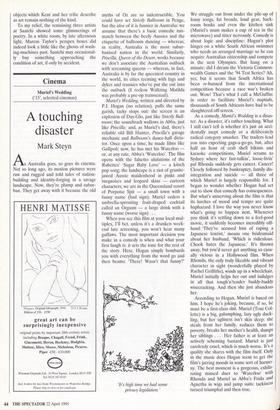Exhibitions
Young British Artists IV (Saatchi Gallery, till 25 June)
Lost generation
Giles Auty
Ii art today, much of what goes on has become beyond parody. A spoof Saatchi show with a spoof catalogue by Sarah Kent would require no great ingenuity to render it indistinguishable from the real thing. Just One of the problems I have with the art Charles Saatchi collects is its extreme diversity and wildly fluctuating quality. No single, human sensibility seems to be at work and one wonders if Mr Saatchi may not subscribe instead to some weird, cab- balistic system: to buy every fifth work he is offered, for instance, when the moon is in a certain phase. It might help, of course, if the collector could explain his purchases or even his policy. As it is, he seems unwilling to offer anything at all in the way of eluci- dation. For me, this casts a huge question Mark over his supposed status as a leading collector. Saatchi has received a great deal of sycophantic press coverage but the time is overdue now to call a halt.
Marcus Harvey is one of five young artists featured in the present Saatchi sym- posium. His work is among the more unpleasant and brainless I have come across. If you could conceive the paintings of a football hooligan who was high on can- tharides you would get the general picture. Yet because she is paid — one hopes hand- somely — to write the catalogue notes for all Saatchi exhibitions, Sarah Kent, a viru- lnt feminist by nature, leaps to Harvey's defence. Her catalogue entries have entered a realm not just beyond parody but which strain the silken threads of sense. `For him painting is a similarly orgiastic experience, an abandonment of control. He psyches himself up to complete a painting in one session since, as in sex, the materials must be wet . . . ' In fact, Harvey spreads hideously coloured paint by hand in the manner of a small child smearing excre- ment, then adds the sharp black outlines learned from his esteemed mentor Michael Craig-Martin to delineate 'crotch, anus, a pair of tight knickers, suspenders, stocking tops, labia and pubic hair'. Needless to add, Mr Harvey is a former student of Gold- smith's College where he was in the care of the ubiquitous Craig-Martin who is now Professor of Fine Art.
From the extreme low point of Harvey's art, the present show of five youngish artists can only improve, although unfortu- nately the catalogue's written explanations fail to follow suit. Many may think that to be collected by Saatchi and written about by Kent is some kind of accolade but I wonder whether it is not a condition deserving of the most profound sympathy, the mark of belonging to a generation of young artists lost beyond redemption. The five artists in question are all male and were all born between 1960 and 1967. Three received their final, soi-disant artis- tic education at Goldsmith's College and one at Chelsea School of Art.
As a result of his inspired training, Gavin Turk seems to feel that all that is needed to be an artist is an ability to write his own name, which he does on a blank canvas and circular mirror, otherwise appending some examples of slightly masticated chewing gum to the lid of a perspex box. But even such trivial actions are enough to slip his avid apologist instantly into gear. Of the last piece, Ms Kent avers . . the subject is death and the traces we leave behind. Turk offers only the residue of a meaningless act.' One hesitates to imagine what Ms Kent's sentiments may be on confronting the objects on her dressing table. Thus how could she bear to wield a hairbrush, say surely a noted, traditional instrument of maternal coercion and punishment — with- out suffering agonies of introspective remorse? I have tried, with growing despair, to explain to Ms Kent and others that certain classes of inert and untrans- formed object are most unsuitable vehicles with which to try to convey universal mean- ing. They may remind Ms Kent personally of this and that — hardly of wider interest if they remain inherently incapable of invoking the same responses in the rest of us. When still a student, Turk exhibited a blue ceramic heritage plaque of the kind which adorns former residences of the famous, stating he had worked in the Bor- ough of Kensington 1989 – 91. By the stan- dards normal to conceptualists and followers of Joseph,Beqs this action might pass for wild humour. Kent avers not only that this plaque alludes to the death of Beuys but that it 'also refers to other deaths; to the end of art, which always seems to be approaching . . . ' One does not wish to appear unsympathetic but the question must be asked: 'How does it do any of these things?' To which the answer must be that it does not and cannot except possibly in the strange minds of Turk him- self and Kent. If Turk really set out to do any or all of these things he needed to find a more apt expressive means. While the search for such means may indeed help cre- ate art, the inert and generally inexpressive
Gavin Turk's 'Pop, 1993, glass, brass, MDS, fibre glass, wax, clothing and gun
objects which Kent and her tribe describe as art remain nothing of the kind.
To my relief, the remaining three artists at Saatchi showed some glimmerings of poetry. In a white room, by late afternoon light, Marcus Taylor's perspex boxes did indeed look a little like the ghosts of wash- ing-machines past. Saatchi may occasional- ly buy something approaching the condition of art, if only by accident.



























































 Previous page
Previous page